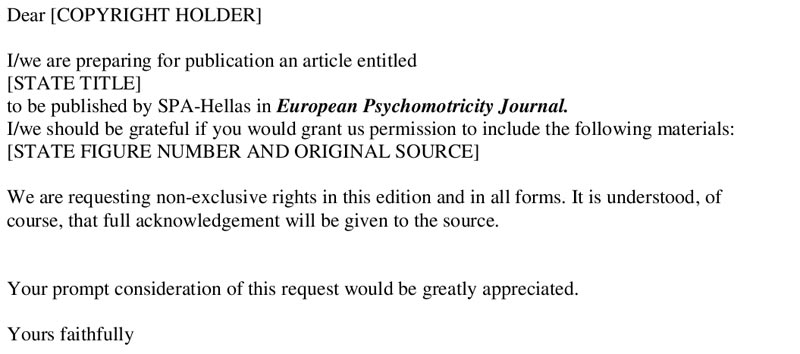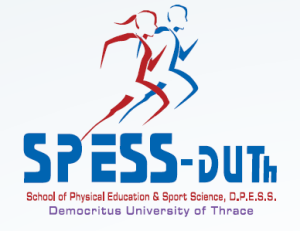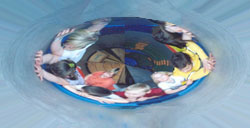All articles published in EPJ is licensed under a CC BY-NC-ND license.
1. Preparation of Manuscripts
Manuscripts must be written in English. Text should be supplied in a format compatible with MS Word for Windows. Charts and tables are considered textual and should also be supplied in a format compatible with MS Word. All figures should be supplied in .jpg format. All manuscripts must be typed in 12pt font and in double space with margins of at least 2.5 cm. Papers should not exceed 20 pages including tables and figures. Authors should prepare manuscripts according to the Publication Manual of the American Psychological Association (APA) (5th ed.). Using the APA as a guide, pay particular attention to manuscript content and organization (pp. 3-30), editorial style (pp. 77-268), and manuscript preparation (pp. 283-305). Check format against APA sample paper (pp. 305-320). Note that Method is singular, and the heading, Participants, is preferred over Subjects. Insert line numbers 1-17 in the left margin of each page, beginning with the abstract page. This facilitates providing line-by-line feedback. Indicate relevance by referring to theories, paradigms, or conceptual frameworks and briefly reviewing the existing knowledge base. Use person-first, non-sexist language in your writing, according to PMPA standards (pp. 61-76). APA (pp. 24-26) requires reporting both statistical significance and effect size, when appropriate.
Title page. This should contain the article title, a running head not exceeding 50 characters (including spaces), 3-5 keywords and full contact details of the authors. One corresponding author should be identified, whose e-mail address will be provided.
Abstracts. Authors submitting papers should note that abstracts are required (150-200 words). These should outline the questions investigated, the design, essential findings and main conclusions of the study.
Text. This should in general, but not necessarily, be divided into sections with the headings: Introduction, Methods, Results, Discussion, Conclusion, Applications.
Tables and Figures. Tables and figures should be referred to text as follows: Figure 1, Table 1. The place at which a table or figure is to be inserted in the printed text should be indicated clearly on a manuscript. Each table and/or figure must have a legend that explains its purpose without reference to the text. Artwork submitted for publication will not be returned and will be destroyed after publication, unless otherwise requested.
References. EPJ uses the APA system to indicate references in the text, tables and legends. The full references should be listed alphabetically, and presented following the text of the manuscript.
Manuscripts for consideration should be submitted electronically, as a single attachment to an e-mail, to the Journal’s editorial office at
3. Author-Side-Fees
The submission and peer-review of manuscripts are free of charge. After the positive evaluation of a paper, 80 Euros (€) have to be paid by the author –side so as that paper to be published. The details for the bank transfer are provided to the authors as soon as their manuscript is accepted for publication.
4. Copyright
It is a condition of publication that authors vest or license copyright in their articles, including abstracts, in SPA-Hellas. This enables us to ensure full copyright protection and to disseminate the article, and the EPJ, to the widest possible readership in print and electronic formats as appropriate. Authors may, of course, use the material elsewhere after publication providing that prior permission is obtained from SPA-Hellas. Authors are themselves responsible for obtaining permission to reproduce copyright material from other sources. The following form of words can be used in seeking an e-permission:

5. Supplementary Material
SUBMISSION OF SUPPLEMENTARY MATERIAL
These are guidelines for the submission of supplementary material to the journal including animations, movie files and sound files that can be accessed via the online edition and additional information, including indexes and calendars.
- All files of supplementary material should be submitted in an uncompressed format that can be used universally on PCs and Macs. All files should be kept to a minimum size where possible.
- Files should be submitted to the journal editor along with the manuscript. If required please supply a legend(s) or description(s) with the additional material to be mounted online and a reference to the file.
- Authors who are unable to submit in any of the formats mentioned are advised to contact the publisher to discuss other options prior to submission.
ANIMATION
Animations are limited to 30 seconds. Animations in the following forms (in order of preference) can be accepted from authors:
- Video tape
- AVI’s, QuickTime or Mpeg’s files
- A sequence of still images
The following formats can be accepted:
- All uncompressed formats widely used on PC, Mac, and UNIX
- JPEG for coloured and compressed images (suffix .jpeg)
- TIFF with a group IV compression for black and white compressed images (suffix .tiff)
- EPS files for vector and a combination of vector and bitmap images (suffix .eps)
- FLI and FLC format from AutoDesk.
Authors who submit animations are requested to provide the following information:
- Video tape – format used.
- AVI, QuickTime or Mpeg files – version used, and system used for disk file creation.
- Sequences of still images – format used, version, and system used for disk file creation.
Authors who are unable to supply the following: videotape, AVI, QuickTime or Mpeg file(s), may provide the publisher with a set of sequential still images. Note that an animated sequence will consist of 13 to 15 still images per second of animation; e.g., if an animated sequence is 10 seconds in duration, it is made up of 130 images. Animation should be mentioned in the text. Indicate an approximate location for the animation call-out in the margin.
MOVIE FILES
Movie files should be submitted as AVI, QuickTime or Mpeg file. These should be uncompressed and in a universal format for PC or Mac. For ease of download, the recommended upper limit for the size of a single file is 10 Megabytes. When the size of a single file is bigger than this, some users may experience problems when downloading. Whenever possible, therefore this limit should be adhered to.
A file which is 1 gigabyte in size is very large and we would request that this file is revised to at least a quarter of the size (even at a quarter of the size it will be a relatively large file) if possible. The sizing of the file is vital for those users accessing the Internet via slow speed dial-up connections. In these circumstances large files are extremely lengthy to download which can be frustrating for users.
SOUND FILES
Sound files should be submitted as .WAV or .MP3 files. These should be uncompressed and in a universal format for PC or Mac.
- All files should be kept to a minimum size where possible.
- A legend or description of the sound file to be mounted online should be supplied to the editor.
ADDITIONAL INFORMATION
Additional text files, such as legends, indexes and calendars should be supplied in a standard word processing document such as MS Word or PDF with the correct links/URL(s) if applicable. Standard positioning online for additional information is after the “Abstract” and before the “References” or on the “Table of Contents”, please state if you require different positioning online.





